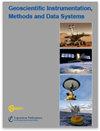Towards agricultural soil carbon monitoring, reporting, and verification through the Field Observatory Network (FiON)
IF 2.3
4区 地球科学
Q3 GEOSCIENCES, MULTIDISCIPLINARY
Geoscientific Instrumentation Methods and Data Systems
Pub Date : 2022-02-16
DOI:10.5194/gi-11-93-2022
引用次数: 7
Abstract
Abstract. Better monitoring, reporting, and verification (MRV) of the amount, additionality, and persistence of the sequestered soil carbon is needed to understand the best carbon farming practices for different soils and climate conditions, as well as their actual climate benefits or cost efficiency in mitigating greenhouse gas emissions. This paper presents our Field Observatory Network (FiON) of researchers, farmers, companies, and other stakeholders developing carbon farming practices. FiON has established a unified methodology towards monitoring and forecasting agricultural carbon sequestration by combining offline and near-real-time field measurements, weather data, satellite imagery, modeling, and computing networks. FiON's first phase consists of two intensive research sites and 20 voluntary pilot farms testing carbon farming practices in Finland. To disseminate the data, FiON built a web-based dashboard called the Field Observatory (v1.0, https://www.fieldobservatory.org/, last access: 3 February 2022). The Field Observatory is designed as an online service for near-real-time model–data synthesis, forecasting, and decision support for the farmers who are able to monitor the effects of carbon farming practices. The most advanced features of the Field Observatory are visible on the Qvidja site, which acts as a prototype for the most recent implementations. Overall, FiON aims to create new knowledge on agricultural soil carbon sequestration and effects of carbon farming practices as well as provide an MRV tool for decision support.通过野外观测网络(FiON)实现农业土壤碳监测、报告和验证
摘要为了了解不同土壤和气候条件下的最佳碳农业实践,以及它们在减少温室气体排放方面的实际气候效益或成本效益,需要更好地监测、报告和验证土壤固碳的数量、附加性和持久性。本文介绍了由研究人员、农民、公司和其他发展碳农业实践的利益相关者组成的实地观测网络(FiON)。FiON通过结合离线和近实时现场测量、天气数据、卫星图像、建模和计算网络,建立了监测和预测农业碳封存的统一方法。FiON的第一阶段包括两个密集的研究地点和20个自愿试点农场,在芬兰测试碳农业实践。为了传播数据,FiON建立了一个基于网络的仪表板,称为野外观测站(v1.0,https://www.fieldobservatory.org/,最后访问时间:2022年2月3日)。野外观测站被设计为一项在线服务,为能够监测碳农业实践影响的农民提供近实时模型数据合成、预测和决策支持。野外观测站最先进的特征可以在Qvidja站点上看到,它是最新实现的原型。总体而言,FiON旨在创造关于农业土壤碳固存和碳农业实践影响的新知识,并为决策支持提供MRV工具。
本文章由计算机程序翻译,如有差异,请以英文原文为准。
求助全文
约1分钟内获得全文
求助全文
来源期刊

Geoscientific Instrumentation Methods and Data Systems
GEOSCIENCES, MULTIDISCIPLINARYMETEOROLOGY-METEOROLOGY & ATMOSPHERIC SCIENCES
CiteScore
3.70
自引率
0.00%
发文量
23
审稿时长
37 weeks
期刊介绍:
Geoscientific Instrumentation, Methods and Data Systems (GI) is an open-access interdisciplinary electronic journal for swift publication of original articles and short communications in the area of geoscientific instruments. It covers three main areas: (i) atmospheric and geospace sciences, (ii) earth science, and (iii) ocean science. A unique feature of the journal is the emphasis on synergy between science and technology that facilitates advances in GI. These advances include but are not limited to the following:
concepts, design, and description of instrumentation and data systems;
retrieval techniques of scientific products from measurements;
calibration and data quality assessment;
uncertainty in measurements;
newly developed and planned research platforms and community instrumentation capabilities;
major national and international field campaigns and observational research programs;
new observational strategies to address societal needs in areas such as monitoring climate change and preventing natural disasters;
networking of instruments for enhancing high temporal and spatial resolution of observations.
GI has an innovative two-stage publication process involving the scientific discussion forum Geoscientific Instrumentation, Methods and Data Systems Discussions (GID), which has been designed to do the following:
foster scientific discussion;
maximize the effectiveness and transparency of scientific quality assurance;
enable rapid publication;
make scientific publications freely accessible.
 求助内容:
求助内容: 应助结果提醒方式:
应助结果提醒方式:


